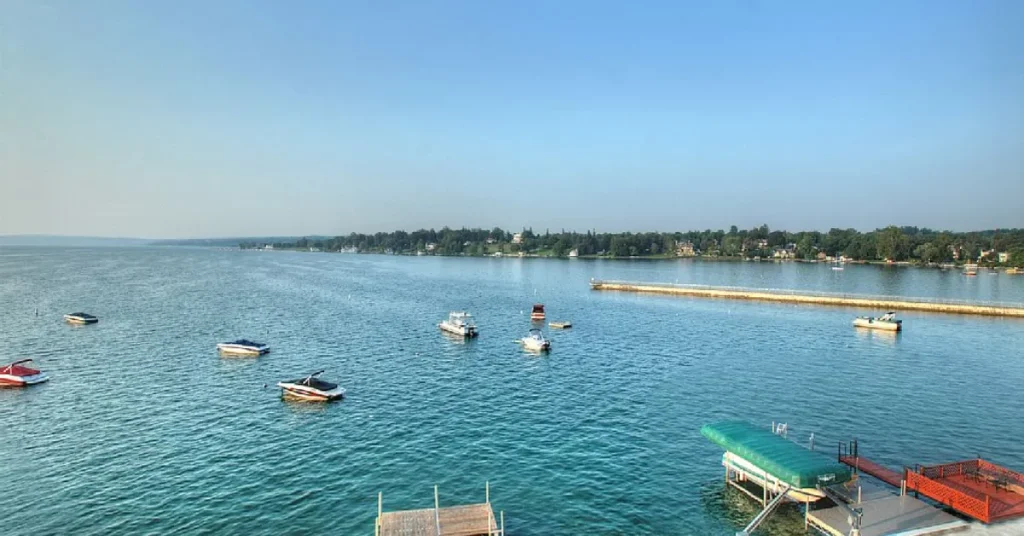Skaneateles Lake has a maximum depth of approximately 315 feet. This serene body of water in central New York is notably clean and clear.
Skaneateles Lake, often celebrated for its pristine quality and breathtaking scenery, is a gem among the Finger Lakes. Its crystal-clear waters draw visitors for a multitude of recreational activities, from boating to fishing.
Encompassed by rolling hills and vibrant greenery, this lake spans roughly 16 miles in length, providing an idyllic backdrop for both relaxation and adventure.
As a source of drinking water for nearby residents, its depth contributes to its chilly and refreshing nature, maintaining a high standard of natural purity.
Tourists and locals alike cherish Skaneateles for its tranquil waters and the charming town that shares its name, creating a perfect escape from the hustle and bustle of daily life.

Exploring Skaneateles Lake’s Depths
Nestled in the Finger Lakes region of New York, Skaneateles Lake beckons adventurers and nature lovers alike.
Its depths hide submerged secrets and draw visitors from near and far. Let’s dive into what makes this lake so captivating, peering into its deep blue mysteries.
The Allure Of Clear Waters
Skaneateles Lake’s pristine waters create a mirror-like surface that mesmerizes onlookers. Its crystal-clear visibility extends far beneath the surface, enticing divers and swimmers to explore. Here’s what sets it apart:
- Exceptional water clarity
- Visibility that can reach up to 30 feet
- Natural springs contributing to its purity
A Glance At Geological Features
The lake’s formation dates back thousands of years, revealing a landscape sculpted by natural forces. Its geological richness adds to its allure. Here are its features breaking the surface:
| Feature | Description |
| Depth | Measured at staggering depths of up to 315 feet, it is one of the deepest in the region. |
| Glacial Origins | Formed during the last Ice Age, glacial activity carved out the basin now filled with glacial blue waters. |
| Underwater Topography | Features diverse contours with steep drop-offs and dramatic underwater hills. |
History Of Depth Measurements
Peering into the depths of Skaneateles Lake reveals more than just water: it shows years of dedication to understanding this natural wonder. The story of measuring its depth is a tale of technology and tenacity.
Skaneateles Lake, a jewel of the Finger Lakes, holds many secrets beneath its surface. Unraveling these mysteries started centuries ago, with early depth explorations, and continues today with modern underwater mapping techniques.
Early Explorations And Records
Initial attempts to gauge the depth of Skaneateles Lake date back to the 1800s. Locals and scientists alike were curious about the lake’s mysterious bottom.
- Hand lines and sinkers: Early methods involved simple tools.
- Notations in journals and maps captured these findings.
- Consistency and accuracy were initial challenges.
Advancements In Underwater Mapping
The quest for precision led to a technological evolution in charting the lakebed.
- Introduction of sonar technology marked a major leap.
- Lake surveys became more systematic and reliable.
- GPS integration further enhanced depth charting.
Today, digital mapping offers the clearest picture yet of Skaneateles Lake’s depths.
Measuring Techniques And Tools
Exploring the depths of Skaneateles Lake requires precision and the right tools. Various methods and tools have evolved over time to measure the depth of water bodies accurately.
Traditional Sounding Methods
In the past, explorers relied on traditional sounding methods to gauge the depths of lakes and oceans.
- Lead lines – a simple tool with a weight attached to a rope, marked at intervals.
- Marked ropes or chains – used with weights to measure depth directly beneath a boat.
These methods, while basic, provided essential information for early cartographers.
Modern Sonar Technology
Today’s techniques utilize modern sonar technology for a more precise measurement of Skaneateles Lake’s depth.
- Echo sounders – devices that use sound waves to find the distance between the lake’s surface and bottom.
- Multibeam sonar – advanced tools that create detailed images of the underwater terrain.
- Side-scan sonar – helps in mapping the lakebed by capturing detailed pictures to the side of a vessel.
These high-tech methods offer an accurate view of underwater landscapes and help to map out the lake’s features in detail.
To understand the depth of Skaneateles Lake, scientists combine both traditional and advanced techniques for the most accurate results. With such tools, we can appreciate the lake’s beauty both above and below the surface.
The Deepest Points Of The Lake

Skaneateles Lake sparkles in New York’s Finger Lakes region. Its waters are not only clear but remarkably deep. Exploring the depths of this pristine lake reveals a world of underwater secrets.
Current Recorded Depths
Divers and sonar equipment work together to map the lake’s floor. These efforts unveiled surprising depths.
- Maximum Depth: Over 300 feet (91 meters)
- Average Depth: Approximately 160 feet (49 meters)
Such impressive figures place Skaneateles among the deepest in the region. The lake’s deepest point is famously known as “The Hole.”
“The Hole” is a must-see for experienced divers. It boasts a depth well over 300 feet, a testament to the lake’s glacial origins.
Comparisons With Other Finger Lakes
Each Finger Lake has its own charm and depth. Skaneateles stands out with its depth, but how does it compare to its siblings?
| Lake | Maximum Depth (feet) |
| Seneca Lake | 618 |
| Cayuga Lake | 435 |
| Skaneateles Lake | >300 |
| Keuka Lake | 187 |
| Canandaigua Lake | 276 |
Seneca Lake dives deeper than Skaneateles, holding the title for the deepest lake in the region.
Cayuga comes in second, with Keuka and Canandaigua following. Skaneateles ranks impressively among these natural wonders.
Impacts Of Depth On Ecosystem
The depth of Skaneateles Lake is a critical consideration when examining its aquatic life and water quality. Let’s dive into how the lake’s impressive depth impacts its ecosystem.
Habitats Within The Lake
Diverse habitats flourish at different depths of Skaneateles Lake. The variability in depth creates unique environments:
- Shallow regions foster the growth of aquatic plants, providing food and shelter for fish and insects.
- Deeper zones offer cooler, darker waters where certain fish species thrive away from surface predators.
- Bottom habitats are home to organisms adapted to the lake’s deepest, most nutrient-rich layers.
Each habitat supports its own web of life, maintaining a balanced ecosystem.
Influence On Water Temperature And Quality
Skaneateles Lake’s depth directly affects its water temperature and quality:
| Depth Range | Temperature Influence | Quality Impact |
| Surface layers (0-20 ft) | Warmer, affected by sunlight | Better oxygen, supports life |
| Middle depths (20-100 ft) | Gradual cooling | Clear, with reduced algae |
| Deep waters (100+ ft) | Cold, stable temperatures | Pure, with limited light penetration |
Overall, the depth fosters a range of temperatures that ensures a high-quality water environment suitable for different species.
Recreational Activities And Lake Depth

Skaneateles Lake is a hub for water enthusiasts. The lake’s pristine waters offer a variety of activities. Its depth greatly enhances these experiences. Whether you love fishing, boating, or diving, understanding the lake’s dimensions adds to the safety and enjoyment.
Diving Adventures
Skaneateles Lake is a dream for divers. The lake reaches deep, offering clear waters for underwater exploration. Here’s why diving here is extraordinary:
- Crisp visibility: The lake’s clarity makes it perfect for spotting aquatic life.
- Depth variety: Ranging from shallow shores to deep waters, divers of all levels find suitable spots.
- Rich ecology: Diverse species thrive in different depth zones, providing much to discover.
Boating And Depth Considerations
Boating on Skaneateles Lake is a popular pursuit. When boating, depth knowledge is crucial. These points ensure safe and fun boating:
- Know the depths: Familiarize with lake maps and depth charts to navigate safely.
- Avoid shallow areas: Watch for buoys and markers that warn of shallow zones to prevent damage.
- Safe anchoring: Use depth data to anchor properly, ensuring your vessel stays secure.
Boaters cherish the ample space above and beneath their vessels. The lake’s maximum depth reaches around 300 feet. This depth offers safe passage for most boats and the thrill of deep-water anchoring for adventurous souls.
FAQs About How Deep Is Skaneateles Lake
What Is The Maximum Depth Of Skaneateles Lake?
Skaneateles Lake reaches a maximum depth of approximately 300 feet. This depth makes it one of the deepest in the Finger Lakes region.
How Does Skaneateles Lake Depth Compare To Other Finger Lakes?
Compared to its neighboring Finger Lakes, Skaneateles Lake is quite deep. Only Seneca and Cayuga Lakes exceed its maximum depth, both over 400 feet deep.
Why Is Skaneateles Lake’s Depth Significant For Its Ecosystem?
The depth of Skaneateles Lake affects its water temperature and clarity. Cooler, deeper waters host unique aquatic life and help maintain the lake’s renowned purity.
Can You Swim In Skaneateles Lake’s Deep Waters?
Yes, swimming is allowed in Skaneateles Lake. However, swimmers should be cautious, due to its significant depth and possible sudden drop-offs.
Conclusion
Diving into the depths of Skaneateles Lake reveals its impressive expanse, reaching down to over 300 feet at its deepest point. This pristine body of water offers not only recreational delight but also a natural ecosystem worth preserving.
For explorers and nature enthusiasts alike, the lake’s depths hold wonders that mirror the serenity of its surface.
Remember, Skaneateles Lake—a deep treasure trove of aquatic beauty—awaits your discovery.
Resources:
1. https://dec.ny.gov/places/skaneateles-lake
